#iPhone battery
Text
Owners of the iPhone 14 and 14 Pro are expressing dissatisfaction with the declining battery capacity.
Some iPhone 14 and iPhone 14 Pro users are experiencing battery degradation concerns akin to the “batterygate” debacle. Within a year of usage, these individuals are witnessing a faster-than-expected decline in battery capacity. A prime example is Sam Kohl, who recently tweeted that his iPhone 14 Pro’s battery capacity had already dropped to 90 percent, a much swifter decline compared to his…

View On WordPress
#Apple#battery degradation#battery replacement#batterygate#capacity drop#iPhone 14#iPhone 14 Pro#iPhone 15#iPhone battery#performance throttling
2 notes
·
View notes
Text
#iphone battery#iphone battery issues#iphone battery maintenance#iphone battery tips#iphone battery replacement
0 notes
Text
Are iPhone Batteries Losing Capacity Too Quickly?
Recent discussions have revolved around the iPhone's battery lifespan, with numerous users expressing concerns about their iPhone 14 batteries dropping to around 90% capacity or even lower. Apple's official stance on the matter states that their lithium-ion batteries are engineered to retain a minimum of 80% original capacity across a substantial number of charge cycles, with the specific count varying based on the product.
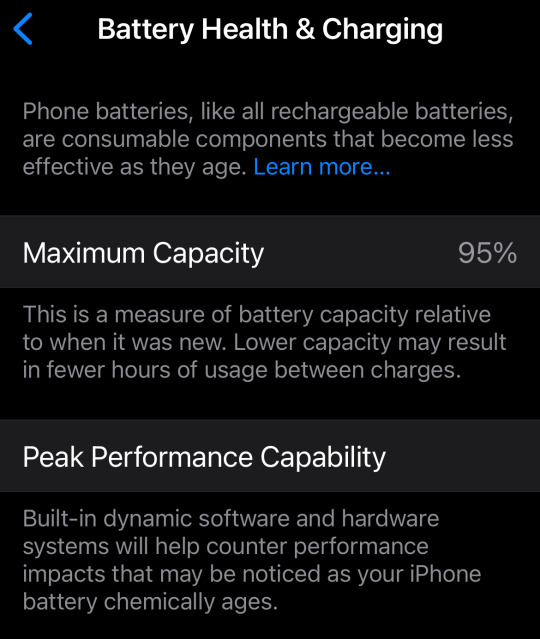
Taking a closer look at my own iPhone 13 Pro, I've observed that it currently boasts a maximum capacity of 95%, having undergone 297 charge cycles in the span of 13 months, which equates to roughly 1.38 days per cycle. A point of intrigue lies in the interplay between maximum capacity and cycle count. In a fascinating twist, my iPhone 13 Pro's battery capacity during the manufacturing phase measured a robust 3174 mAh, surpassing Apple's officially documented 3095 mAh.
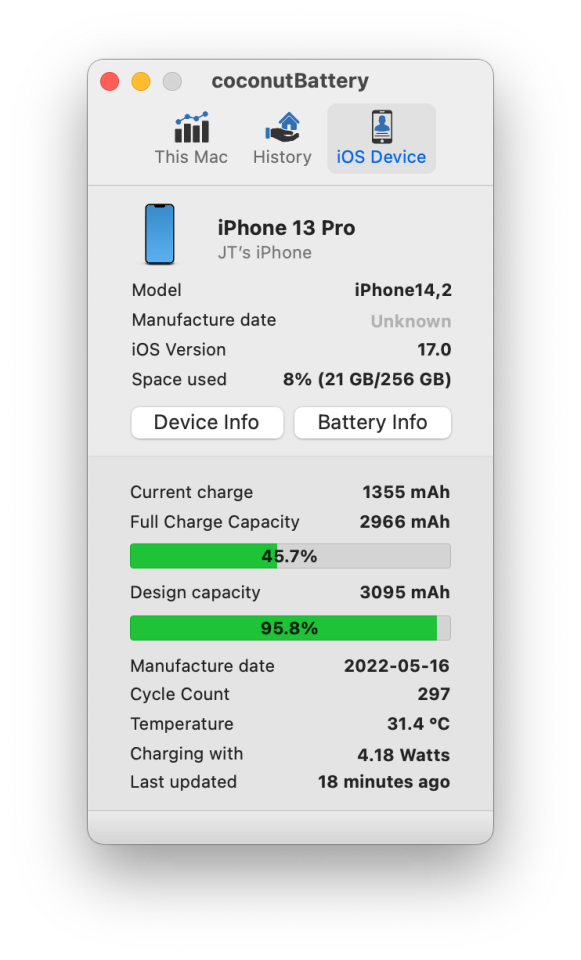
This intriguing phenomenon appears to hold true for every one of the five iPhones within my household. Cycle count, the next pivotal factor, emerges into the spotlight. The fact that I've accrued 297 cycles over a span of 411 days prompts contemplation. Apple aptly clarifies this aspect in their explanations. Yet, when we attempt to mesh the concept of 95% capacity into this narrative, it appears to be a divergent tangent.
My own computations reveal that the 95% capacity figure doesn't neatly correlate. Upon closer examination, my current full charge capacity stands at 2964 mAh. By extrapolating the math, my original manufactured capacity tallied up to 3174 mAh, culminating in a present capacity of 93.38%. If we recalibrate these figures against Apple's design capacity of 3095 mAh, the recalculated percentage stands at 95.77%.
In the grand scheme of things, is this truly an issue? My perspective leans toward the negative. Operating under the assumption that the 80% threshold represents the point at which Apple might consider battery replacement, I find myself comfortably distant from that juncture, potentially even a few hundred cycles away.
Notably, instances have surfaced wherein phones exhibit around 80% capacity after undergoing upwards of 800 cycles in less than a year.
iPhone 14 battery drain is a thing. People talking about it on TikTok. I’ve never used MagSafe charger, but mine already at 88% 😵💫 pic.twitter.com/PW9CKs6aRu
— Miraflor Photo (@BryanMiraflor) August 15, 2023
In essence, the ongoing discourse surrounding iPhone battery life warrants consideration. By dissecting the interplay between capacity, cycle count, and manufacturer specifications, it's clear that the situation isn't as dire as some might suggest. Remaining well above the 80% capacity threshold, I'm left reassured about the longevity of my device's battery and the resiliency of Apple's engineering.
0 notes
Text
Troubleshooting Guide: iPhone Stuck On Battery Charging Screen
If you have an iPhone and you notice that the iPhone is stuck on the charging screen when you want to charge it after the battery is low. This is how-to-fix such issues on your iPhone. Before you follow the troubleshooting method to fix your iPhone Stuck on red charging screen mode, you should do this… This method works on iPhone 6, 6S, iPhone 7, 7 Plus, iPhone 8, 8 Plus, iPhone X, XS, XR, XS…
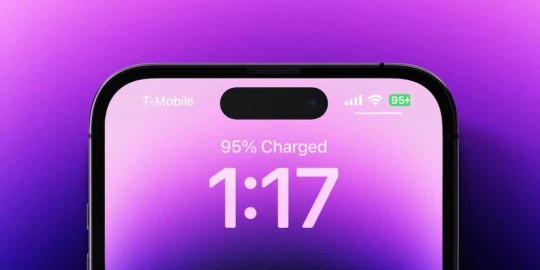
View On WordPress
0 notes
Text
Why iPhone's Battery Does Not Last As Android? IOS Vs Android Battery Backup Which Is Best?
In the realm of smartphones, battery longevity has always been a crucial factor for users. While both iPhones and Android devices offer a multitude of features and functionalities, it is often observed that iPhone batteries tend to drain faster compared to their Android counterparts. So, if you are also one of those who always feel stuck in a debate over IOS vs Android battery backup then, be…

View On WordPress
0 notes
Text
#iPhone battery replacement#esourceparts#iphone parts#iphone screen repair#iphone battery#iphone battery replacement#iphone
1 note
·
View note
Text

4 Signs Your iPhone Battery Needs a Replacement
0 notes
Text
iPhone 14 Battery Capacities For All Four Models Revealed Ahead of Launch

Three out of four iPhone 14 models feature larger battery capacities compared to the iPhone 13 lineup, with the exception being the iPhone 14 Pro Max, which is equipped with a slightly smaller battery compared to the iPhone 13 Pro Max.
Battery capacities for the iPhone 13 lineup:
iPhone 13 mini: 2,406 mAh
iPhone 13: 3,227 mAh
iPhone 13 Pro: 3,095 mAh
iPhone 13 Pro Max: 4,352 mAh
Battery capacities for the iPhone 14 lineup:
iPhone 14: 3,279 mAh
iPhone 14 Plus: 4,325 mAh
iPhone 14 Pro: 3,200 mAh
iPhone 14 Pro Max: 4,323 mAh
Apple says all four iPhone 14 models feature "all-day battery life." iPhone 14, iPhone 14 Pro, and iPhone 14 Pro Max models feature up to one hour longer battery life for offline video playback compared to the equivalent iPhone 13 models, according to tech specs on Apple's website, while there is no directly comparable model for the iPhone 14 Plus.
Click Here to Learn more about iPhone 14 and iPhone 14 Pro.
Visit techonlinedeals.com to see the best deals.
1 note
·
View note
Text
honestly I encourage everyone to get comfortable opening up their electronics. game consoles. computers. phones. keyboards. headphones. whatever. like obviously don't start with the most difficult thing to open up and don't just mindlessly pop open something and lose all the screws and don't do it while its on. but get comfortable looking inside your stuff yourself
its not hard to open up most electronics that don't have an apple logo on them (and even a lot of those are easier than you'd think) and it DOES NOT VOID YOUR WARRANTY.
Companies will try to scare you from learning how to care for your own stuff because they get money that way. Warranty stickers are technically illegal in the US but just isn't enforced, and a company can't actually void your warranty if you repair something yourself, so long as you don't break something else in the process.
like I look at threads all the time where people express fear about just opening up a console and looking at the internals to see which version they have but don't be! its easy, its safe, its free! get comfortable with your electronics and learn how to clean and repair stuff yourself, it isn't scary, companies just want you to think it is!
#I have been inside of like a dozen different video game consoles at this point#i'm talking like atari 2600 through X Box 360 in terms of generations#newer ones I've just had no reason to open up so that's the only reason I haven't tho I should probably do some cleaning#but like I've done cleaning and repasting and straight up surgery on motherboards and its FINE its not hard#I don't even know how to use a soldering iron and I have still done repairs and maintenance that would cost stupid amounts#I've taken part ipods regularly and removed puffy batteries from iphones and popped open headphones to replace parts they don't want replac#i've frankensteined keyboards from different ones to make what I wanted and built ones I myself#as long as you're careful and don't fuck around with power supplies that are ON or act reckless with batteries#its FINE#open up your junk and clean it
174 notes
·
View notes
Text

Nesting ✨
#spnfanart#destiel#destiel fanart#spncreatorsdaily#dean winchester#castiel#wiggleart#I’m waiting for my iPhone to back up so I can get#it’s battery replaced and I wanna go back to sleep and I’m still in a fluffy domestic mood#after all the media I’ve consumed in the last couple of weeks so#cuddle doodle
339 notes
·
View notes
Text
Pro-tip; give your ancient vampires memory issues so that when you inevitably fuck up your historical research you can attribute it to 'he done forgotted'
#it's a lot of time to hold in your brain#there's story reasons why#like they just have a jacked up human brain#it's like#idk#think of a human brain as like an iphone#there's only a certain amount of storage on that thing#so when they become vampires#even though they get new software which optimises flow better and means the battery never dies#they still only have that set amount of storage space#and their brains do this auto-smart-storage thing#where they just delete files that aren't used to optimise new memories#so you'd just forget so much stuff#bc your brain just has no room#not quite dead
115 notes
·
View notes
Text
Angrily rocking back and forth in this armchair at this AirBnb because I just had to spend [redacted] on a new phone while also losing ~2 months worth of photos and all my Notes app notes
#i feel like pingu#the latter is my own fault of course but let's not talk about that#i'll be ok once i a. pick up the new one and switch the sim b. get signed into my email c. re-set up work 2fa#shoshi.txt#i knew i was on borrowed time with an iphone 8 but i just replaced the battery this year#and then like four different things went wrong with it this afternoon and none of us (me sister sister's bf) could fix it. so.#i'm done. new phone it is then.
14 notes
·
View notes
Text
honestly the odds of me even being able to play ml on my own phone are probably low but that’s a problem for future me
#got an iphone SE… could be worse but could be better#battery life isn’t great anymore and also storage …#kingdom hearts#khml
11 notes
·
View notes
Text
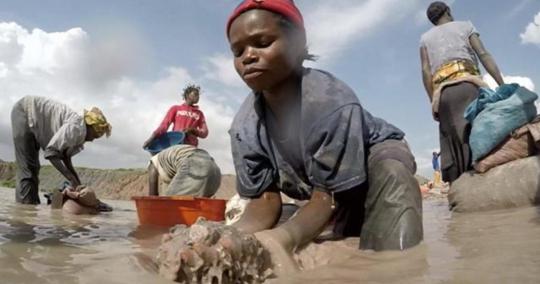
Children still mining cobalt for gadget batteries in Congo
A CBS News investigation of child labor in cobalt mines in the Democratic Republic of Congo has revealed that tens of thousands of children are growing up without a childhood today – two years after a damning Amnesty report about human rights abuses in the cobalt trade was published. The Amnesty report first revealed that cobalt mined by children was ending up in products from prominent tech companies including Apple, Microsoft, Tesla and Samsung.
There's such sensitivity around cobalt mining in the DRC that a CBS News team traveling there recently was stopped every few hundred feet while moving along dirt roads and seeing children digging for cobalt. From as young as 4 years old, children can pick cobalt out of a pile, and even those too young to work spend much of the day breathing in toxic fumes.
What's life like for kids mining cobalt for our gadgets?
So, what exactly is cobalt, and what are the health risks for those who work in the DRC's cobalt mining industry?
What is cobalt?
Cobalt – a naturally occurring element – is a critical component in lithium-ion, rechargeable batteries. In recent years, the growing global market for portable electronic devices and rechargeable batteries has fueled demand for its extraction, Amnesty said in its 2016 report. In fact, many top electronic and electric vehicle companies need cobalt to help power their products.
The element is found in other products as well.
"Cobalt-containing products include corrosion and heat-resistant alloys, hard metal (cobalt-tungsten-carbide alloy), magnets, grinding and cutting tools, pigments, paints, colored glass, surgical implants, catalysts, batteries, and cobalt-coated metal (from electroplating)," says the U.S. Centers for Disease Control and Prevention.
More than half of the world's supply of cobalt comes from the DRC, and 20 percent of that is mined by hand, according to Darton Commodities Ltd., a London-based research company that specializes in cobalt.
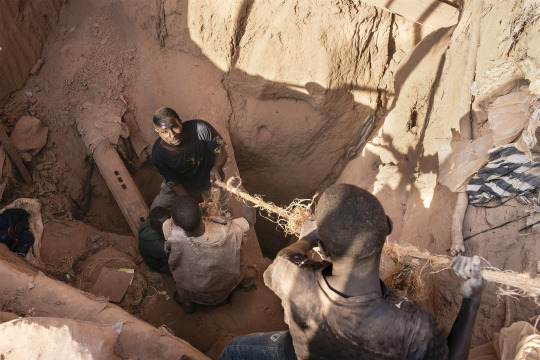
Health risks of chronic exposure
According to the CDC, "chronic exposure to cobalt-containing hard metal (dust or fume) can result in a serious lung disease called 'hard metal lung disease'" – a kind of pneumoconiosis, meaning a lung disease caused by inhaling dust particles. Inhalation of cobalt particles can cause respiratory sensitization, asthma, decreased pulmonary function and shortness of breath, the CDC says.
The health agency says skin contact is also a significant health concern "because dermal exposures to hard metal and cobalt salts can result in significant systemic uptake."
"Sustained exposures can cause skin sensitization, which may result in eruptions of contact dermatitis," a red, itchy skin rash, the CDC says.
Despite the health risks, researchers with Amnesty International found that most cobalt miners in Congo lack basic protective equipment like face masks, work clothing and gloves. Many of the miners the organization spoke with for its 2016 report – 90 people in total who work, or worked, in the mines – complained of frequent coughing or lung problems. Cobalt mining's dangerous impact on workers and the environment
Some women complained about the physical nature of the work, with one describing hauling 110-pound sacks of cobalt ore. "We all have problems with our lungs, and pain all over our bodies," the woman said, according to Amnesty.
Moreover, miners said unsupported mining tunnels frequently give way, and that accidents are common.
Miners know their work is dangerous, Todd C. Frankel wrote late last month in The Washington Post.
"But what's less understood are the environmental health risks posed by the extensive mining," he reported. "Southern Congo holds not only vast deposits of cobalt and copper but also uranium. Scientists have recorded alarming radioactivity levels in some mining regions. Mining waste often pollutes rivers and drinking water. The dust from the pulverized rock is known to cause breathing problems. The mining industry's toxic fallout is only now being studied by researchers, mostly in Lubumbashi, the country's mining capital."

"These job are really desired"
Despite the dangers and risks of working as miners in the cobalt industry, at least of the some miners in the Congo "love their jobs," according to Frankel.
"When I talked to the miners there, none of them want to lose their jobs or give up their jobs. They love their jobs," Frankel said Tuesday, speaking on CBSN. "In a country like Congo, mining is one of the few decently paying jobs to be had there, and so they want to hold onto these jobs."
They also want fair treatment, decent pay, and some safety, "and they would love for their kids to not work in the mines," he said.
"It's a poverty problem," Frankel said. "These parents I talked to – they don't want their kids working in these mines. The problem is that their school fees – schools cost money, and you know, food costs money, and they sort of need their kids to work in there."
Poverty also drives children into the mines instead of school – an estimated 40,000 of them work in brutal conditions starting at very young ages.
The thousands of miners who work in tunnels searching for cobalt in the country "do it because they live in one of the poorest countries in the world, and cobalt is valuable," Frankel wrote in the Washington Post article.
"Not doing enough"
CBS News spoke with some of the companies that use cobalt in their lithium-ion batteries. All of the companies acknowledged problems with the supply chain, but said they require suppliers to follow responsible sourcing guidelines. Apple, an industry leader in the fight for responsible sourcing, said walking away from the DRC "would do nothing to improve conditions for the people or the environment."
Read company responses here
Amnesty said in November, however, that "major electronics and electric vehicle companies are still not doing enough to stop human rights abuses entering their cobalt supply chains."
"As demand for rechargeable batteries grows, companies have a responsibility to prove that they are not profiting from the misery of miners working in terrible conditions in the DRC," the organization said. "The energy solutions of the future must not be built on human rights abuses."
An estimated two-thirds of children in the region of the DRC that CBS News visited recently are not in school. They're working in mines instead.
CBS News' Debora Patta spoke with an 11-year-old boy, Ziki Swaze, who has no idea how to read or write but is an expert in washing cobalt. Every evening, he returns home with a dollar or two to provide for his family.
"I have to go and work there," he told Patta, "because my grandma has a bad leg and she can't."
He said he dreams of going to school, but has always had to work instead.
"I feel very bad because I can see my friends going to school, and I am struggling," he said.
Amnesty says "it is widely recognized internationally that the involvement of children in mining constitutes one of the worst forms of child labour, which governments are required to prohibit and eliminate."
#cobalt#PD Congo#PDR Congo#cobalt mining by children#amnesty university#The toll of the cobalt mining industry on health and the environment#Congo Economic Theft#minerals#rare earth minerals#tesla#iphones#cellphone batteries#ev batteries#lithium batteries#child labour#forced child labor#poverty#systemic racism
49 notes
·
View notes
Text
Yo, my mom's getting a new phone and she's finally allowing me to try and move her away from iPhones. What phones do y'all recommend, and do you have anti-Apple propaganda I can share with her?
#apple#ios#apple computers#iphones#phones#technology#apple phones#i've got a moto g power#it's got good battery life and a headphones jack#dunno if that's what my mom would be interested in though#i'm concentrating on steering away from apple before looking for what she might like instead
7 notes
·
View notes
